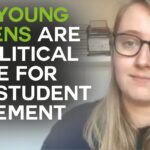You can tell this wasn’t the ‘usual suspects’
By Beth Tichborne
Was it spoilt middle-class kids making unrealistic demands, or was it thuggish anarchists undermining the mainstream peaceful movement? What happened at Millbank is already being twisted uncomfortably into any available stereotype in a nervous effort to explain it away.
For once the chant “this is not a riot” had no place. This was a riot. It looked like one, it felt like one. Us ‘middle-class kids’ who’ve been trying to engage in democracy at Make Poverty History, various Climate Camps and Vodafone occupations were there, but we were a minority. Some of the NUS lot, who’ve been practising their speeches in front of the mirror for six months, were there, but they were an even smaller minority. The anarchists, masked up and well stocked with megaphones and flags were there, but even they were a minority. Going to Millbank might have been their idea in the first place, and they might have been the first on the roof, but it wasn’t their protest.
The majority were just plain old students, but angry. The kind of students who go to their lectures, go to parties, play sport at the weekends and sometimes get a bit drunk and lairy. And there were a lot of very young students there. Maybe they were first years, but many of them looked like school students. They weren’t all middle class, they weren’t all white, they hadn’t all come in on the student union buses. They were never looking at the Russell group education that private and grammar school educated kids could, until now, take for granted. These are the people who made up the majority of the people at Millbank – ordinary young people, working class and middle class, from school age up to university age, who hadn’t been on many demos before, whose only encounter with the police, or with agitated crowds, had been Saturday night lairiness or sports matches.
And that set the mood. It felt like a rowdy night in a busy town. People were angry and frustrated, and they hadn’t had the training or the experience to deal with the situation. If it was true that a militant anarchist faction had led the violence at Millbank then here’s what it would have looked like:
Everybody facing the police line would have had a mask on. Nobody would plan to feature prominently in national newspapers with their face clearly exposed, throwing a stick at a police officer or smashing a window. But what did we actually see? A few make-shift bandannas slipping down people’s faces and a huge number of students who hadn’t even tried to hide their identity.
The police line would have been stormed. There was a large plate glass window missing, right in front of the crowd. There were hundreds of protestors, there were a laughably small number of police. Very little organisation would have been required for everybody to link up and just walk through the police line, with little damage done to either side. Instead there a mass of people hanging back, and a handful of angry people launching themselves one by one at the police with fists or sticks to be beaten back with batons.
When the snatch squad was sent in their targets would have been surrounded and protected by fellow protestors. Instead the crowd allowed the police to get to their targets and then to carry them back out, right through the bulk of the protestors. The reaction was angry, and violent, but completely ineffective. It was clear that people didn’t understand what was happening until it was over.
There would have been a sense of purpose. I did quite a bit of chatting and eavesdropping. People didn’t know what was going on. Not just the people milling around near the back. Students in university hoodies who were right up near the front, the ones who were launching sticks as if they were javelins, were confused. They asked each other if anyone was in charge, they wondered if they were going to miss their bus back, they talked about ‘kettling’ as something that they’d heard of but never experienced. They had a slightly dazed look, part exhilaration, part anger, but partly just the look of someone trying to cope with a situation that they’ve never been in before. There was no one in charge, so they made it up. And a number of them got it wrong.
Millbank showed what happens when a generation realises that they are being disenfranchised. We voted, it didn’t count. We’ve marched before, literally millions of us, and that didn’t count. What do we do now? We occupy, we disobey, we wave flags and shout from rooftops. We’re angry, and a lot of us haven’t done this before. Violence provokes violence, and the cuts are violent. Yesterday that showed. We can hope that the non-violent tactics used by movements like ukuncut and climate camp will spread. And student groups around the country are already actively trying to do this, by offering training in non violent direct action to anyone who wants it. We also need student leaders to stand by those students who are taking direct action, not to reject the people who are most vulnerable and have the least access to a voice in the national media. Condemn the stupidity of dropping a fire extinguisher on a crowd, of course. But the masses who swarmed peacefully into the lobby through open doors should be heroes. And the students who were throwing sticks, let’s try and win them round. At the moment they seem to be caught between a rock and the NUS – riot or student politicians with an eye on their future career. We need to make the alternative option clear – occupation, good; trying to hurt people, bad. Is that so complicated?






>Who is the victim of this state violence? >Really a victim? Not someone who has to make >some changes to their lives but someone whose >life is actually threatened?
The first victims are the hidden people. Someone posted this on the Oxford Save our Services website:
“We have a daughter with multiple and profound disabilities. Oxfordshire is cutting her care budget 40%. They are threatening to force her to move to different and much cheaper care home against her consent. They are taking away her budget for support to leave her home. The DWP is cutting her Incapacity Benefit (Disabled Living Allowance) and cut her mobility benefit. She will become a prisoner in some dreadful place where no body knows her or understands her.”
Destroying the quality of life of disabled people is terrible in it’s own right. It will also mean that there are many people who cannot communicate verbally who will no longer have the level of care needed to respond to their physical needs. Serious health problems are already underdiagnosed in people with profound disabilities. It’s an inequality that already kills. This is about to get much worse. So there’s one clear cut case of how the cuts will hurt people physically. Then there’s homelessness, that’ll go up, that takes years from people’s lives.
And democracy can’t possibly mean the opportunity to choose every few years between almost indistinguishable parties that then don’t even do what they said they would.
‘What about the reception staff in the building? What about the other staff in the building who had nothing to do with the Tories or even the cuts? ‘
What are you talking about? Were these staff, along with Tory cabinet members such as Baroness Warsi who were in the building lynched, beaten and torn limb from limb by this violent mob?
No. None of them were injured, let alone hospitalised or killed. The violence you claim to abhor was carefully targeted violence at symbolic objects, not people. Most of us understand a clear distinction between damaging objects/property and damaging people.
‘And the cuts are not violent. Who is the victim of this state violence? Really a victim?’
So the disabled who will losing benefits they depend upon aren’t victims? People who are forced to move out of areas they’ve lived in all their lives because of housing benefit changes aren’t victims? People who are no longer guaranteed medical treatment within 18 weeks on the NHS but now have to wait an indeterminate amount of time for surgery to alleviate pain aren’t victims?
Do you really feel that breaking a few windows causes more pain and suffering than any of the above? If so can I suggest that your ability to empathise with other human beings is severely dysfunctional.
‘Some spending changes may be unfair. But they can be changed in 1600 days. We have elections.’
So when politicians lie during a campaign to get themselves elected (the Tory campaign argued for 6bn worth of cuts not over 80bn, while the Lib Dems claimed they were going to abolish student fees not triple them)we should all just wait five years and allow them to wreak havoc in the meantime.
You appear to be somewhat mistaken. Democracy means rule of the people, not subordination to lying politicians.
“Yes, let’s vote for parties who pledge never to impose increased fees, and if they get into government that’ll solve it.
Oh, wait…”
That is my point. If that pledge is so important that its worth rioting over, I am sure that it will affect which boxes get the 1,2,3 at the next UK elections (or x if the referendum fails). That’s how democracy works is it not?
Or does this site forego the ballot box in preference of mob rule as was demonstrated this week?
Well written – I couldn’t agree with you more!
The Telegraph has launched a manhunt against protesters. Email (creative) responses to studentriots@telegraph.co.uk
Yes, let’s vote for parties who pledge never to impose increased fees, and if they get into government that’ll solve it.
Oh, wait…
It was an interesting piece until:
“violence provokes violence, and the cuts are violent” and “But the masses who swarmed peacefully into the lobby through open doors should be heroes”
At what point of proximity to a violent mob is being part of a violent mob? Did the policewomen taken away with blood on their faces deserve the violence done to them? What about the reception staff in the building? What about the other staff in the building who had nothing to do with the Tories or even the cuts?
And the cuts are not violent. Who is the victim of this state violence? Really a victim? Not someone who has to make some changes to their lives but someone whose life is actually threatened? Some spending changes may be unfair. But they can be changed in 1600 days. We have elections. The Tories and Libs can be punished if thats what you want. Violence is the removal of democracy (or even the removal of the right to peaceful protest).
Is the storming of a lobby and the damage to people, property and fixtures and fittings really non-violent direct action? Even if not a single stone was thrown can you imagine working their and that happening to you – anger being projected towards where you are despite you having nothing to do with it?
If young people are supposed to be the future I dont like the future offered by those in London earlier this week or those supporting them.
The masks and the ‘soft’ police reaction may indicate they were infiltrators from our oh so not completely democratic police force & governemnet ; out to discredit strongly held views of the majority – think about it!
Very well written.
And as students gazed up at the tower, they might have wondered (had they known) how many student grants could be financed from the tax being avoided by parking ownership of this building in the British Virgin Islands.
http://www.andywightman.com/wordpress/?p=105
Fantastic post
I think you may have hit the nail on the head